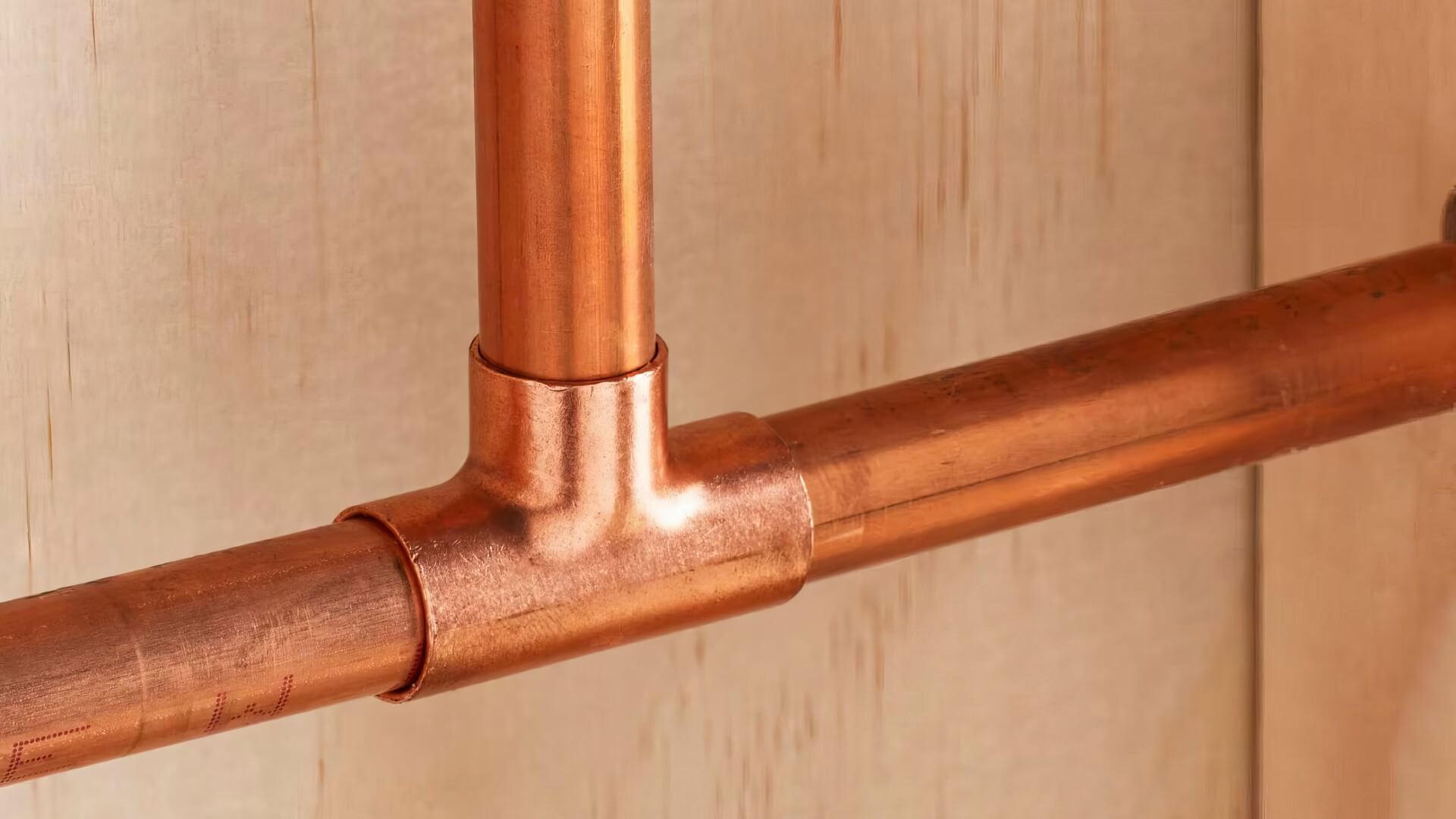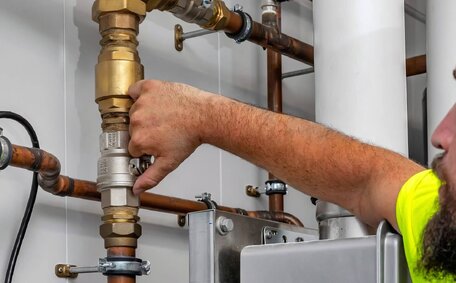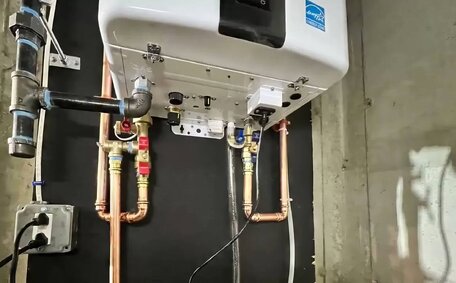What Is Gas Line Pressure Testing?
Gas line pressure testing validates the safety and integrity of natural gas pipelines. It involves pressurising installed gas lines with compressed air or an inert gas like nitrogen to pressures higher than the normal operating pressure.
The purpose of a pressure test on gas lines is to ensure there are no leaks or weaknesses in the piping before connecting appliances. Even minute leaks, if undetected, can cause a small amount gas to escape, creating a hazardous circumstance.
During a pressure gas line test, the line’s pressure must comply with local plumbing codes and fuel gas standards.
Technicians monitor the line for changes in pressure over time to detect irregularities. An allowable leakage within prescribed limits is permitted, but a more significant drop pressure may indicate a leak.
Pressure testing is crucial for any new gas connections before the meter is connected and appliances are fired up. All new installations require a pressure test gas line procedure to receive approval. Many local codes also require a leak test during alterations, extensions, repairs, or replacement of gas piping systems.
Proper training and equipment are critical for the safe execution of gas pressure tests. While DIYers can purchase pressure test gauges, We recommend engaging a certified gas fitter to conduct the process for safety and compliance.
When Are Gas Line Pressure Tests Required?
Gas line pressure testing is mandatory for ensuring the safety of gas systems in various scenarios:
- After installing a new gas line or appliances
- Following alterations, extensions, or repairs to existing gas lines
- Replacement of pipes, fittings, or joints in a gas distribution system
- If a leak is suspected or reported in the gas line
- When installing a new gas meter, especially for hot water systems
- Before relighting gas appliances after an interruption of service
- After any incident, accident or natural event that may have caused damage
Local regulations often dictate that any serviced natural gas line in your premises must undergo testing. The test verifies that the piping can safely withstand the standard gas line pressure supplied from utility mains.
Annual test gas line may also be needed for commercial kitchens, laboratories, manufacturing facilities or other locations with extensive gas piping networks. Periodic tests on such heavy-duty systems ensure any leaks or damage is caught early on.
While not always mandated, it is advisable to retest after seismic activity, floods, storms, or other structural damage where there’s no evident damage. There might be some tiny holes or loose joints imperceptible to the eye that may still allow dangerous gas leakage.
DIYers can purchase test gauges to learn about gas lines checking, but For accurate guidance, always consult a professional. However certified gas fitters have the proper specialised equipment and expertise to thoroughly inspect all fixtures, perform testing safely, and issue compliance certificates.
Safety Considerations for Gas Line Pressure Testing
Gas line pressure testing requires strict safety protocols to prevent accidents and injuries:
- Don protective equipment such as work gloves, closed-toe footwear, safety glasses and helmets
- Ensure the gas supply valves to appliances are shut off prior to starting the test
- Ventilate closed areas to avert the build-up of gas
- Carefully release pressure relief valves if over-pressurisation occurs
- Have fire extinguishers and first aid kits readily available
- Obtain necessary permits and follow all local regulations
- Place warning signs indicating testing is in progress
- Make sure all piping connections are secure before pressurising
- Monitor test gauges at all times and do not leave unattended
Uncertified individuals should refrain from conducting gas line pressure tests on their own. The procedure requires technical expertise to be performed safely. Professional gas fitters are properly trained and equipped to conduct testing while following all safety guidelines.
When in doubt, Consult qualified technicians at your gas utility company for pressure gas testing guidance. Never attempt to measure gas pressure or test piping yourself without proper guidance, equipment and permits.
How Technicians Perform Gas Line Pressure Tests
Certified gas fitters follow strict procedural guidelines when pressure testing gas lines. The key steps involved are:
- Review piping layout diagrams and specs to determine test locations, durations and target pressures based on pipe length and diameter as per code.
- Inspect all joints, valves, connections and materials before starting.
- Seal off piping openings and outlets using appropriate caps, ensuring they are capped off securely.
- Shut off gas supply at mains and metre.
- Attach the test gauge and pressurisation device to the outlet most distant from the gas source.
- Use compressed air or nitrogen to gradually achieve the target pressure in testing natural gas pipelines.
- Maintain a pressure below the maximum operating level for at least 15 minutes, observing the gauge and attentively listening for any leaks.
- If gauge indicates a drop in pressure greater than permissible, search systemically to detect and tag leaks.
- Release test pressure gradually, fix leaks and retest section until acceptable results.
- Provide compliance certificate on passing test to client and authorities.
The duration of a strength pressure test ranges from 15 minutes to 24 hours, based on the pipe size and local regulatory requirements. The accepted pressure loss depends on codes but is often less than 10% of the test gauge reading.
Technicians ensure that they perform tests within the boundaries of their qualifications. Procedural documentation is maintained and necessary permits and gas isolation precautions are acquired. Tests are conducted outdoors whenever feasible for safety.
Equipment Used for Gas Line Pressure Testing
Certified gas technicians use specialised equipment to conduct pressurised leak tests on gas pipelines. The key items include:
- Pressure gauges - Test gauges feature large dual scales that indicate pressure in ounces per square inch (oz/in2) and pounds per square inch (psi). They are calibrated and certified for accuracy.
- Electronic pressure data loggers - These devices constantly record and document system pressure over time during the test. Sudden drops are easy to identify.
- Tubing kits - Tubing allows connection of test equipment to appliance gas valves or line outlets to fill pipelines with test media.
- Sealing plugs - A variety of tapered plugs are used to seal sections, outlets and appliance ends during testing.
- Flowmeters - Rotary gas flowmeters measure and regulate the filling flow rate to avoid excessive pressurisation.
- Compressed gas cylinders - Either nitrogen or compressed air is used as test media to fill lines to specified pressures.
- Leak detection fluids & detectors - Bubble test solutions along with electronic gas detectors help accurately locate leaks.
- Warning signs & barriers - Visual signs indicate ongoing testing while barriers prevent unauthorised access to test areas.
Proper calibration and operation of pressure testing apparatus is vital for conducting procedures safely while achieving valid compliant results.
Interpreting Gas Line Pressure Test Results
Interpreting the results of a gas line pressure test requires analysing pressure gauge readings taken before, during and after the specified test duration.
Technicians aim to ensure the test gas pressure is at least the required minimum during the procedure. Pressure loss guidelines are typically based on pipe specifications as per regional fuel gas codes. Acceptable loss is often less than 10% of the test gauge pressure reading.
If within limits, it indicates the gas line is free of leaks and able to safely hold pressure when eventually connected to active gas supply. The system passes the test.
A pressure drop greater than 10% usually signals potential gas leaks. Technicians must then systematically check all connections, joints, valves and materials until the leak source is identified and sealed. Retesting follows repair actions.
For small, simple household lines up to 3m, pressure should remain steady at less than 3 psig throughout the test. Larger volume pipe networks serving multiple appliances require higher pressure for working gas test compliance.
DIYers attempting tests must compare readings against code limits, not general rules of thumb. When in doubt, consult gas fitters to evaluate your test results against compliance standards.
DIY Gas Line Pressure Testing Tips
While gas line pressure testing requires professional expertise for definitive results, DIYers can conduct basic checks by following important guidelines:
- Purchase an approved test gauge able to read pressure in ounces per square inch (oz\/in2).
- Familiarise yourself with the allowable pressure loss limits as per local fuel gas codes.
- Seal off all outlets and openings using plugs rated for gas service.
- Test short sections of pipe, maintaining a pressure of less than 3 psig, to simplify leak detection.
- Pressurise the line with a psi test, increasing the pressure slowly with air to no more than 3 PSI.
- Hold pressure for 15 minutes, monitoring for drops exceeding 10% of gauge reading.
- Check joints with non-corrosive leak solution to spot bubbles.
- Release pressure gradually after testing and remove seals.
- Seek professional assistance to evaluate results and issue compliance certificates.
While DIY tests can provide some indication of leaks, only certified gas fitters have the tools, qualifications and expertise to thoroughly pressure test the line being tested as per codes. If attempting self-tests, exercise extreme caution at all times.
When to Call a Professional for Help
While basic gas line pressure testing can be done as a DIY project, there are important situations when you must contact a licenced professional plumbing company like Epping Plumbing Services for assistance:
- If you need to install or alter gas lines in any way
- To conduct official pressure testing for compliance or certification
- If you suspect a gas leak or have identified one during testing
- To reignite pilot lights or restore appliances to service subsequent to repairs or tests
- When you require technical advice on pressure testing procedures or results
- If there is a substantial and unexplained drop in pressure according to the test results
- To issue formal documentation of test compliance for authorities
Our fully certified and insured gas technicians have the expertise and working pressure tools and equipment to handle all gas line testing needs for residential and commercial settings. We follow the latest regional plumbing codes and fuel gas standards for guaranteed safety and compliance.
Call Epping Plumbing Services on 1300 349 338 for expert pressure testing and leak detection in the Epping region. Our friendly team is ready to help 24/7. You can also email us or book an appointment online.






